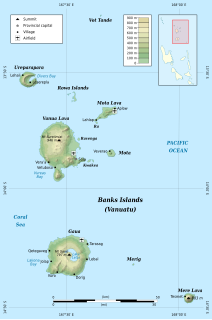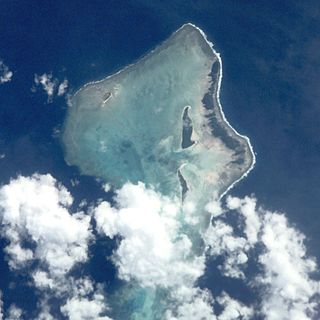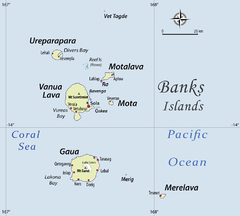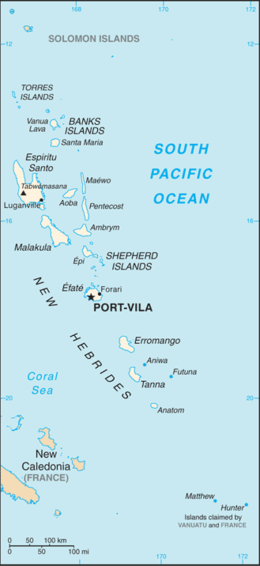
Melanesia is a subregion of Oceania in the southwestern Pacific Ocean. It extends from the island of New Guinea in the west to Tonga in the east, and includes the Arafura Sea.

The Torres Islands are in the Torba Province of the country of Vanuatu, and is that country’s the northernmost island group. The chain of islands that make up this micro-archipelago straddles the broader cultural boundary between Island Melanesia and several Polynesian outliers located in the neighbouring Solomon Islands. To the island chain’s north is Temotu Province of the Solomon Islands, to its south is Espiritu Santo, and to its southeast are the Banks Islands. To the west, beneath the ocean surface, is the deep Torres Trench, which is the subduction zone between the Australian and Pacific plates.

John Coleridge Patteson was an English Anglican bishop, missionary to the South Sea Islands, and an accomplished linguist, learning 23 of the islands' more than 1,000 languages.

The Banks Islands are a group of islands in northern Vanuatu. Together with the Torres Islands to their northwest, they make up the northernmost province of Torba. The island group lies about 40 km (25 mi) north of Maewo, and includes Gaua and Vanua Lava, two of the 13 largest islands in Vanuatu. In 2009, the islands had a population of 8,533. The island group’s combined land area is 780 km².
The Melanesian Brotherhood is an Anglican religious community of men in simple vows based primarily in the Solomon Islands, Vanuatu, and Papua New Guinea.

Erromango is the fourth largest island in the Vanuatu archipelago. With a land area of 891.9 square kilometres (344.4 sq mi) it is the largest island in Tafea Province, the southernmost of Vanuatu's six administrative regions.

Gaua is the largest and second most populous of the Banks Islands in Torba Province in northern Vanuatu. It covers 342 km².

Vanua Lava is the second largest of the Banks Islands in Torba Province, Vanuatu, after slightly larger Gaua.
Mwotlap is an Oceanic language spoken by about 2,100 people in Vanuatu. The majority of speakers are found on the island of Motalava in the Banks Islands, with smaller communities in the islands of Ra and Vanua Lava, as well as migrant groups in the two main cities of the country, Santo and Port Vila.

Mota Lava or Motalava is an island of the Banks group, in the north of Vanuatu. It forms a single coral system with the small island of Ra.

Lorevilko is a village in northeast Espiritu Santo, Sanma Province, Vanuatu. The name comes from the East Santo language and means "wild kava".
Ini Kopuria was a police officer from Maravovo, Guadalcanal, Solomon Islands who founded the Melanesian Brotherhood in 1925. He and the Bishop of Melanesia, the Right Reverend John Manwaring Steward, realised Ini's dream by forming a band of brothers to take the Gospel of Jesus to the non-Christian areas of Melanesia.

The Anglican Church of Melanesia (ACoM), also known as the Church of the Province of Melanesia and the Church of Melanesia (COM), is a church of the Anglican Communion and includes nine dioceses in the Solomon Islands, Vanuatu and New Caledonia. The Archbishop of Melanesia is Leonard Dawea. He succeeds the retired archbishop George Takeli.
The calendar of saints and commemorations in the Church of the Province of Melanesia is a continually developing list. Both old and new, universal and local saints and worthies are celebrated.

Ureparapara is the third largest island in the Banks group of northern Vanuatu, after Gaua and Vanua Lava.
Mota is an Oceanic language spoken by about 750 people on Mota Island, in the Banks Islands of Vanuatu.
The Melanesian Mission is an Anglican missionary agency supporting the work of local Anglican churches in Melanesia. It was founded in 1849 by George Selwyn, the first Bishop of New Zealand.

Merelava is an island in the Banks Islands of the Torba Province of northern Vanuatu.
The Diocese of Banks and Torres is one of the nine current dioceses of the Anglican Church of Melanesia.

Rowa Islands are an uninhabited archipelago in Torba Province of Vanuatu in the Pacific Ocean. The Rowa are a part of larger Banks Islands archipelago. The islands are a natural border between Melanesia and Polynesia; they are one of the most beautiful places in the South Pacific Ocean and an integral part of a vast system of atolls and reefs.














